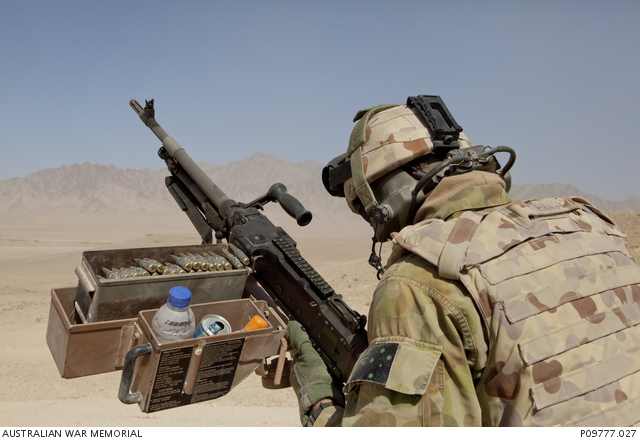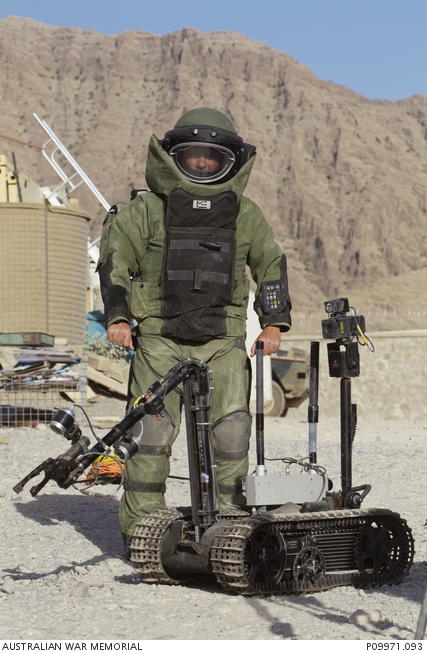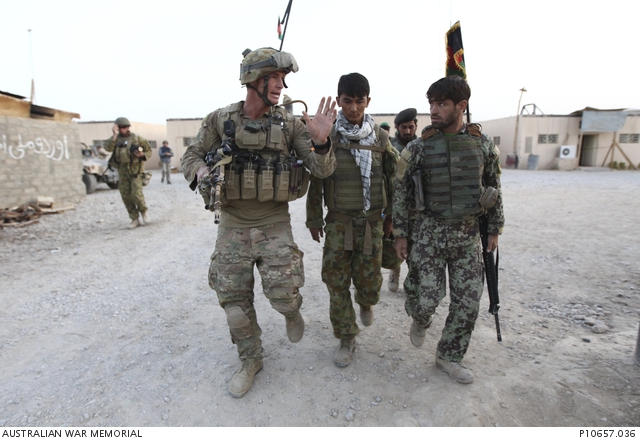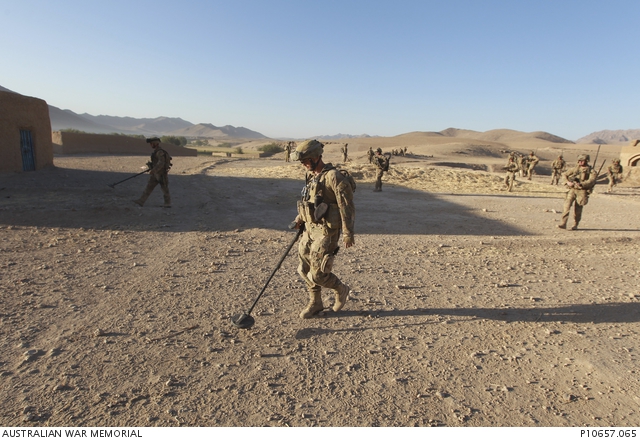Events after 11 September 2001 saw the Middle East return to centre stage for Australia’s armed forces after repeated and sporadic commitments in northern Africa and the Middle East. These dated back as far as 1865, and most prominently during the two world wars: Gallipoli, Mesopotamia (Iraq), Greece, Crete, Palestine and the north African desert. The post-war years had seen small Australian contingents deploy on occasions with the British and the United Nations: Cyprus, as part of the United Nations Truce Supervision Organization; the Multinational Force and Observers in the Sinai; UN Mine Clearance Training Teams in the Afghan–Pakistan border areas; and with the UN Iran–Iraq Monitoring Group. Despite a defence strategy since the Vietnam War years focused on the defence of Australia, government policy recognised the need to protect and advance Australia’s national interests further from Australian shores than had been envisaged in the preceding two decades.
President George W. Bush called it the Global War on Terror. Prime Minister John Howard avoided the term but invoked the then 50-year-old ANZUS Treaty, committing Australian forces from all three services to operations alongside US and coalition forces in the Middle East. This would prove to be a commitment lasting longer than either of the two world wars. This time, though, the government undertook it while avoiding the contentious issues of conscription and heavy own-force casualties. The Howard government managed this by making niche and calibrated force contributions, and by utilising only a professional, all volunteer force.
Afghanistan became the primary target, as the Taliban hosted and was closely associated with the terrorist group al-Qaeda, led by Osama bin Laden, which was identified as the instigator of the 9/11 attacks. The Taliban’s refusal to expel al-Qaeda triggered the intervention and the overthrow of the Taliban. The attacks commenced on 7 October, and within five weeks Kabul had fallen to the US-supported Northern Alliance of Afghan forces. Few Australians realised the fight would continue for years thereafter. In reality, it would mean multiple deployments of ground, maritime and air contingents for the following two decades.

Commitments
In contrast to the commitments to the major wars in the Middle East in the early to mid-twentieth century, Australia did not rely on mass mobilisation of troops. Instead, the Australian government chose to make small contributions to generate carefully constrained strategic effects. There were compelling reasons, beyond the alliance relationship with the United States, for Australia to engage with these security issues, as did many other powers. But with an eye to the political fallout from the Vietnam War, the government sought to minimise domestic political risk that might arise from an open-ended commitment. Each decision to commit forces, therefore, was evaluated for the tactical, operational and strategic consequences – as well as the political consequences that were likely to be generated back home. Notwithstanding these constraints, operations in Afghanistan and elsewhere in the Middle East would provide a wide range of unique additional challenges and opportunities for elements of the ADF to learn and adapt.
The initial land force contingent Australia deployed were special forces, with the 1st SAS Squadron committed on operations in November 2001 as part of a US Marine Expeditionary Unit. Campaigning in Afghanistan ended in mid-2002, and the Australian contingent was withdrawn promptly.
Over the next two years, Australia maintained a low profile in Afghanistan. But the war in Iraq, launched in March 2003, proved not nearly so conclusive as President Bush had anticipated. The security situation in both Afghanistan and Iraq deteriorated, and the United States applied considerable pressure for Australian forces to return to assist. In February 2005, therefore, Prime Minister John Howard committed an additional force to southern Iraq, deployed to Al Muthanna, working closely with coalition partners including Dutch, Japanese and British troops.
It was similar in Afghanistan. The US, having moved on from that theatre of operations to focus on Iraq, found its departure had allowed a resurgence of Taliban forces. By 2005, the calls for coalition partners to bolster the US position there were becoming stronger. As a result, Australia weighed its options. Eager to avoid a commitment that would expose Australia to a major force commitment, significant additional expense and a heightened risk of casualties, the Howard government recommitted a Special Operations Task Group (SOTG) under the banner of Operation Slipper. This time it was to Uruzgan province in central Afghanistan. Special forces had proven to be reliable, being readily deployable, highly professional and less likely to face significant numbers of casualties. Following three SOTG rotations, the First Reconstruction Task Force (RTF1) formed and deployed to Tarin Kot, the central town in Uruzgan. There it worked to build up Afghan society as well as to defeat the Taliban. In April 2007, a SOTG returned to operate alongside the RTF to provide a kinetic war-fighting capability.
As time passed, the focus for the RTFs turned from reconstruction to mentoring and reconstruction. Eventually the focus shifted mostly to mentoring the Afghan National Security Force, with the aim of developing indigenous capacity-building. As part of this approach, efforts were made to ensure that initiatives funded by the Department of Foreign Affairs and Trade and its AusAid projects were coordinated, and that those undertaken by the Australian Federal Police were synchronised with the ADF initiatives as well. This sounded good in principle but proved difficult in practice.

Sharing the load
From one perspective, this carefully calibrated contribution made sense. The Australian commitment to operations in Uruzgan province involved a defined physical area with agreed, limited force contributions and in partnership with a prominent NATO member state, the Netherlands. Initially the Dutch would be in charge. This helped ensure that the Dutch made a significant contribution to the international stabilisation operations in Afghanistan, while keeping Australia’s contribution in check. It also meant that Australia did not have to contribute all the force elements for an effective and holistic counterinsurgency campaign with long-term objectives in mind.
Successive Australian governments led by Kevin Rudd, Julia Gillard and Malcolm Turnbull renewed the commitment to the war in Afghanistan despite mounting losses. Over time, the ADF deployment in Uruzgan generated a growing number of casualties: 41 Australians died on operations, although hundreds more would lose their lives largely from the effects of post-traumatic stress disorder after their return to Australia.
A disproportionate share of the load fell on the shoulders of Australia’s special forces soldiers who deployed in successive SOTG rotations. By 2014, when Australia’s land-force combat operations in Afghanistan had ceased, a large number had been on many such deployments. Eventually, this would lead to over-exposure of those elite troops to the brutality and apparently unending nature of a campaign that lacked clarity of purpose. Consequently, the actions of some led to highly questionable outcomes and accusations of war crimes that would prove corrosive to Australia’s special forces and the broader ADF. In hindsight, this probably should have been seen as the likely if not inevitable outcome of a flawed strategy. Without a holistic counter-insurgency campaign for Uruzgan, let alone Afghanistan, much of the direction of tactical actions fell on the shoulders of soldiers and commanders. In the absence of a compelling overarching strategy, the main campaign plans left Australian and coalition forces with an inadequate raison d’être for the brutal fight they were tasked to undertake.
Beyond the SOTG rotations and the reconstruction and mentoring task forces, Australians were seconded to (i.e. embedded in) coalition units and headquarters in Tarin Kot, Kabul, Kandahar, Bagram and in other locations across Afghanistan. In Tarin Kot, under the Dutch-led Task Force Uruzgan Headquarters, Australian embeds assisted in coordinating missions, campaign planning and mission deconfliction among other duties; they used this experience in joint headquarters to inform Australian planning. This embedded experience allowed Australians not only to practise the art of military operations but also to use the information and experience they gained to inform planning and to refine processes for future Australian deployments.

Other services
Meanwhile, the RAN and RAAF continued to gain excellent operational experience from their carefully calibrated force contributions, and their experience helped to generate momentum for development, introduction into service and refinement of significant capabilities. For the Royal Australian Air force, this involved advances in niche capabilities including airborne refuelling, airborne early warning and control, airborne surveillance, communications and identification systems capabilities – as well as ground-based air traffic control through the RAAF’s deployable Command and Reporting Centre, which deployed to Kandahar from 2007 to 2009.
Almost the entire Royal Australian Navy fleet undertook one or more deployments to participate in intervention and monitoring operations in and around the Persian Gulf for the entire period. This experience helped to justify and refine technological advances, including weapons systems upgrades and enhancements to missile systems and phased array radars.
By 2014, about 1,550 Australian military personnel were stationed in Afghanistan as part of Australia’s military contribution to the international campaign against terrorism. It included providing maritime security in the Middle East Area of Operations (MEAO) and countering piracy in the Gulf of Aden, all under the banner of Operation Slipper. All of this was commanded by a Joint Task Force headquarters sited in the Persian Gulf and answerable to Headquarters Joint Operations Command back in Australia. An additional 830 ADF personnel were deployed across the broader MEAO, often alongside coalition partners, making distinct but important contributions. Australia also maintained a continuous maritime contribution to Operation Slipper, which included RAN frigates on rotation.
It was not just engineers, special forces and infantry that deployed to Afghanistan: a wide range of other military and non-military elements participated. Artillery contingents deployed alongside British counterparts. Intelligence analysts also provided “intimate, timely and actionable” support (“intimate” in the sense of getting close to sources and providing fine-grained detail on the enemy), by drawing on a range of national and technical resources to ensure accurate and relevant analysis could be provided for the deployed forces to use on their patrols. There were significant challenges faced in attempting to deliver humanitarian assistance, as such contributions sometimes complicated the governance arrangements when local power struggles unfolded over control of resources and access to the community.
Australia’s embedded journalists faced remarkable frustration as the Defence Media controllers blocked unfettered access. The Australian government’s interaction with the media was starkly different from that of the United States. Poor lessons were learnt about how to engage with the media in conflict zones and about the responsibility of both journalists and the ADF not to obfuscate on operations. The Australian Federal Police also undertook deployments to Afghanistan. While police are not trained for warlike operational environments as their ADF counterparts are, they nonetheless managed to adapt to the environment. They managed to negotiate bilateral intelligence-sharing agreements, create training doctrine and become an integral part of a coalition policing effort in Afghanistan.
When it came to the engagement of Australian Aid, problems arose from attempting to deliver effective aid and reconstruction in a highly dynamic conflict zone, particularly in a context of sensitive relationships with stakeholders and communities. Ultimately, for all their hard work, the lack of continuity in Afghan leadership, and the absence of central government support for reconstruction and aid driven projects, meant that Australia’s aid efforts would have little lasting positive impact.
Australia’s involvement in Afghanistan saw Australia’s first mass employment of women in combat related roles on warlike operations. However, there was a gender blind spot, and the significance of women’s contribution to operational outcomes was only belatedly appreciated.

Assessment
On reflection, the absence of a cohesive and enduring strategic objective was the main contributor to failings in Afghanistan and elsewhere in the Middle East. One of the striking features of the experience of Australia’s wars in Afghanistan is how each of the decision points along the way seems to have been reached and acted on, mindful of just one underlying long-term concern – the maintenance and support of the US alliance. Yet this approach was undertaken principally with short-term priorities and concerns in mind. It was these short-term factors that drove the tangible contributions the government decided to offer at each juncture.
The Australian government envisaged the offer of the special forces in October 2001 as a one-off and short-term contribution. Subsequent land force contingents sent to the war in Iraq also were carefully contained to exclude post-conflict, or so-called Phase 4, operations to aid in the reconstruction of post-invasion Iraq. Then again, the return of special and conventional land forces to Afghanistan was with relatively short-term priorities in mind. As one quite senior officer cynically confided in 2006 when Australia was redeploying land forces to Afghanistan, that mission had been accomplished: Australia had managed to get the Dutch into Uruzgan province and Australia into NATO. This betrayed a remarkably superficial understanding of what it means to commit Australian young men and women into probable combat.
Little did planners seem to realise that a rotation of land forces, centred on an engineer regiment, the First Reconstruction Task Force (RTF1), would make ensuing demands on Australian forces that successive Australian governments simply were not prepared to meet. Indeed, the deployment of RTF1 came at a time when a crisis in East Timor was stretching the ADF, and particularly its land forces, to the edge. As I pointed out in The Australian Army from Whitlam to Howard, the unprecedented operational tempo saw five of the six Regular Army commanding officers of the infantry battalions in the Royal Australian Regiment deployed on operations concurrently. That was not sustainable without capping Australia’s involvement to carefully calibrated niche contributions.
This pointed to the enduring peacetime mindset that saw no great urgency in expanding the land force in any way remotely akin to the expansion of forces during the Second World War (with its equivalent, in terms of land forces, of 14 divisions), let alone the period of Confrontation and the Vietnam War.
The Vietnam War parallel is particularly instructive, for it was there that the Australian Army, with its nine infantry battalions and associated arms and services that contributed to the brigade-sized 1st Australian Task Force, managed to maintain a rotation of forces through Phuoc Tuy Province in South Vietnam from 1965 to 1971. Eager to avoid the heightened domestic political controversy associated with the expanded force that had been enabled by conscription in the 1960s, the Australian government did not seriously consider a significant force expansion that might have enabled a more robust and holistic force contribution. That was understandable on one level, although arguably an expansion of the force could have been achieved without conscription simply by better and more targeted advertising and improved conditions of service. Instead, repeated rotations placed an unreasonable strain, particularly on the special forces, to the point where their practices led to controversy and even disrepute.
The Vietnam parallel is also instructive in terms of thinking through what matters most to Australia. Beyond seeking to be seen as supportive of the US alliance, Australia’s Defence White Paper of 2016 lists three strategic priorities: a secure and resilient Australia, with secure northern approaches and proximate sea lines of communication; a secure nearer region, encompassing maritime south-east Asia and south Pacific; a stable Indo-Pacific region and a rules based global order. Yet ironically, Australia’s carefully calibrated and constrained force contribution to operations in Afghanistan and Iraq reveals a certain dissonance here. The contrast with Australia’s contribution to the East Timor intervention in 1999 is noteworthy. For that operation, Australia was prepared to be the lead nation, accept hundreds of casualties, if need be, and assume the leadership role to ensure that the 22-nation coalition was successful in its mission.
The approach taken in Afghanistan (and Iraq) stands in contrast. Despite having a significant stake in Uruzgan, Australia was unwilling to offer to lead the provincial efforts on behalf of the coalition. In addition, there was little consideration of how to make a more profound and long-lasting contribution in a province like Uruzgan. This was in part because there was little if any appetite for taking responsibility for the province and driving the agenda there with the long term in mind. Critics might say that this assessment is unfair, as many good people tried very hard, over successive rotations, to make a real difference in Uruzgan. That is true. The point, though, is not to lay blame at the feet of the practitioners who did their best in difficult circumstances. Instead, it is to question the lack of thought-through strategy for what the ADF would do there and what effect it would have on those who served there, let alone what long-term effects their actions would generate in-country. For this, the senior-most military leadership and their political masters must share responsibility: the military for not offering more frank, fearless and far-sighted advice, and politicians for not thinking beyond the prism of their own domestic political cycles.
For Australia, the contributions made to the wars in Afghanistan were deliberately constrained ones. Lessons were learned, experience was gained, capabilities were enhanced and alliance ties were burnished; but the experience was deliberately confined to the theatre of operations. Deployed forces put their heart and soul into their work. Yet there was a genuine reluctance in Canberra to embrace wholeheartedly the demands of the operational areas where Australian troops deployed. As a result, the mission often seemed opaque, the command authority constrained and the story allowed to be told only through the tightly managed media. Looking back, in the hearts of veterans, there is a certain sense of disappointment. Perhaps, as it considers future contingencies, where larger more demanding contributions might be required, Australia can learn from this experience – that it should commit troops when it has formulated clear-eyed strategic goals that we all can live with.
Previously published in Wartime 96
John Blaxland is Professor of International Security and Intelligence Studies at the Australian National University and a former Army officer. He is author of The Australian Army from Whitlam to Howard and co-editor (with Marcus Fielding & Thea Gellerfy) of Niche Wars: Australia in Afghanistan and Iraq, 2001–2014.
Contact John Blaxland about this article.






